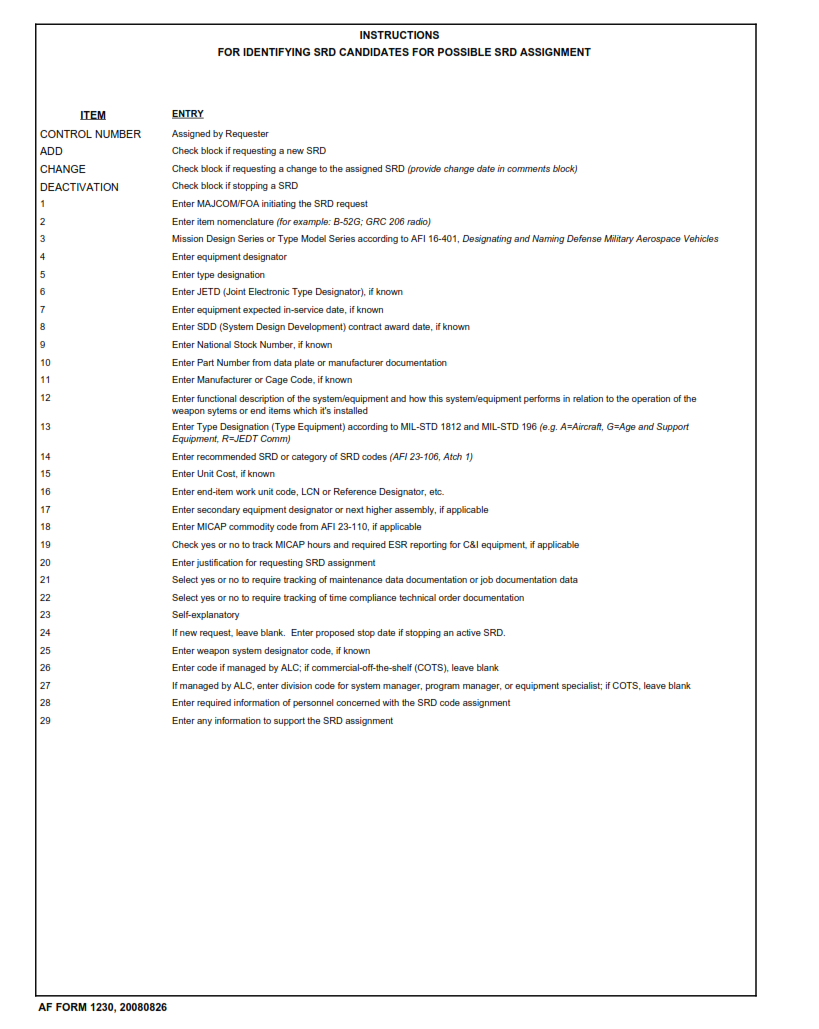FINDERDOC.COM – AF Form 1230 – Standard Reporting Designator (SRD) Candidate Information – AF Form 1230, Standard Reporting Designator (SRD) Candidate Information, is used to designate officers and enlisted members who are in the process of being evaluated for promotion to commissioned officer status. Officers and enlisted members who are designated with an SRD must submit a written report on their candidacy status every six months to their commanding officer or the rating authority above him/her.
Download AF Form 1230 – Standard Reporting Designator (SRD) Candidate Information
| Form Number | AF Form 1230 |
| Form Title | Standard Reporting Designator (SRD) Candidate Information |
| File Size | 23 KB |
| Date | 26-08-2008 |
What is an AF Form 1230?
An AF Form 1230 is a document used by the United States Air Force to record and track information about Standard Reporting Designator (SRD) candidates. The SRD program was established as a way to identify Airmen who have excelled in their current job and display potential for future leadership positions. The form contains personal information such as name, rank, and date of birth along with education, training, and work experience.
The AF Form 1230 is an essential tool for commanders to evaluate their personnel and make informed decisions about promotion opportunities. It provides a comprehensive snapshot of an Airman’s qualifications that can be referenced when considering candidates for career advancement. Additionally, the form serves as a way for Airmen to communicate their strengths and skills that may not be immediately evident through regular job performance.
Overall, the AF Form 1230 plays a crucial role in identifying top-performing Airmen and preparing them for leadership roles within the Air Force. It allows commanders to make fair and informed decisions when it comes to career advancement opportunities while also providing Airmen with an opportunity to showcase their strengths beyond their daily duties.
What is the Purpose of AF Form 1230?
AF Form 1230, also known as the Standard Reporting Designator (SRD) Candidate Information, is a document used by the United States Air Force to gather information on potential candidates for officer training programs. The purpose of this form is to provide a standardized method for capturing data on individuals who are applying for officer candidate school. This form collects basic personal and academic information such as name, rank, education level, and test scores.
It’s important to note that this form does not guarantee acceptance into an officer training program but rather serves as a tool in the selection process. The SRD helps officers evaluate each candidate based on their qualifications and determine if they meet the necessary requirements for commissioning. While filling out AF Form 1230 may seem like a daunting task at first, it’s crucial to carefully complete all sections with accurate information so that your application can be considered fairly.
In summary, AF Form 1230 plays a significant role in identifying qualified candidates for officer training programs in the United States Air Force. Accurate completion of this document can increase one’s chances of being selected for further evaluation and ultimately commissioned as an Air Force Officer.
Where Can I Find an AF Form 1230?
The AF Form 1230, also known as the Standard Reporting Designator (SRD) Candidate Information form, is a document used by the United States Air Force to collect information about individuals who may be eligible for promotion or reclassification. The form is an essential component of the SRD process and helps commanders make informed decisions about personnel assignments and career development.
So where can you find an AF Form 1230? The easiest way to obtain one is through your unit’s personnel office. Your supervisor or commander should know where to access the form within your organization’s internal documentation system. You can also try searching for it on official military websites, such as the Air Force Personnel Center or Defense Logistics Agency. Additionally, there are online resources that provide printable versions of government forms like the AF Form 1230. However, be sure to verify that any online version you find is current and up-to-date before submitting it.
AF Form 1230 – Standard Reporting Designator (SRD) Candidate Information
AF Form 1230, also known as the Standard Reporting Designator (SRD) Candidate Information, is a critical document used by the United States Air Force to identify and track personnel movements. The SRD is used to assign an individual to a specific job or assignment, which allows the Air Force to manage its personnel resources effectively. This form provides essential information about an individual’s skills, education, and experience that are necessary for making informed decisions on assignments.
The SRD candidate information includes details such as name, rank, social security number, education background and work experience. This form also includes details of specialized training received in specific fields such as aviation or technical expertise. The data contained in this form assists supervisors and managers in identifying individuals with particular qualifications required for various positions within the organization.
In conclusion, having accurate and updated information on AF Form 1230 is essential for effective management of human resources in the United States Air Force. With this document’s assistance,
supervisors can match personnel with appropriate job requirements easily. It is crucial that all personnel maintain accurate records so that they can be assigned tasks most suitable for them at any given time.
AF Form 1230 Example

